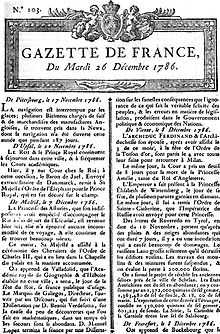La Gazette

La Gazette (French pronunciation: [la ɡazɛt]), originally Gazette de France, was the first weekly magazine published in France. It was founded by Théophraste Renaudot and issued its first number on May 30, 1631. It progressively became the mouthpiece of one royalist faction, the Legitimists.[1] La Gazette disappeared in 1915.
During the Ancien Régime
Before the advent of the printed Gazette, reports on current events usually circulated as hand-written papers (nouvelles à la main). La Gazette quickly became the center of France for the dissemination of news, and thus an excellent means for controlling the flow of information in a highly centralized state.[2] Cardinal Richelieu and Louis XIII were frequent contributors.[3]
Among the early members of the committee supervising La Gazette were Pierre d'Hozier, Vincent Voiture, Guillaume Bautru, and Gauthier de Costes.[2]
La Gazette had for objective to inform its readers on events from the noble court and abroad. It was mostly focused on political and diplomatic affairs. In 1762, its name became Gazette de France, with the sub title Organe officiel du Government royal (Official organ of the royal Government). In 1787, Charles-Joseph Panckouke already proprietary of the Mercure de France and the Moniteur universel—which he had just founded—rented the magazine.
During the Revolution
La Gazette remained silent about the birth of the revolution, and didn't even mention the storming of the Bastille on the 14th of July in 1789, limiting itself to government acts. For the satisfaction of his customers, Charles-Joseph Panckouke published a supplement, Le Gazettin (little Gazette), that gave its readers summaries of debates at the National Constituent Assembly. In 1791, the ministry of foreign affairs, who owned La Gazette, took it back. Nicolas Fallet was named director and it became a tribune for the Girondists. He was succeeded by Sébastien Roch Nicolas Chamfort. La Gazette became a daily magazine in 1792, 1 May. Following the execution of Louis XVI in 1793, 21 January, it was renamed Gazette nationale de France (National Gazette of France) . The tone of its articles remained both very prudent and impartial.
See also
- Ancien Régime in France
- Charles Maurras
- History of French newspapers
- List of the oldest newspapers
References
- ↑ Pascal Ory, "La nouvelle droite fin de siècle" in Nouvelle histoire des idées politiques (dir. P. Ory), Hachette Pluriel 1987, pp.457-465 (French)
- ↑ 2.0 2.1 Harcourt Brown (1972). "History and the Learned Journal". Journal of the History of Ideas (University of Pennsylvania Press) 33 (3): 365–378. doi:10.2307/2709041. JSTOR 2709041.
- ↑ Raphael Levy (1929). "The Daily Press in France". The Modern Language Journal (Blackwell Publishing) 13 (4): 294–303. doi:10.2307/315897. JSTOR 315897.
External links
- La Gazette issues in Gallica, the digital library of the BnF
Bibliography
- Jean Tulard, Jean-François Fayard, Alfred Fierro, Histoire et dictionnaire de la Révolution française 1789-1799, Éditions Robert Laffont, collection Bouquins, Paris, 1987. ISBN 2-7028-2076-X